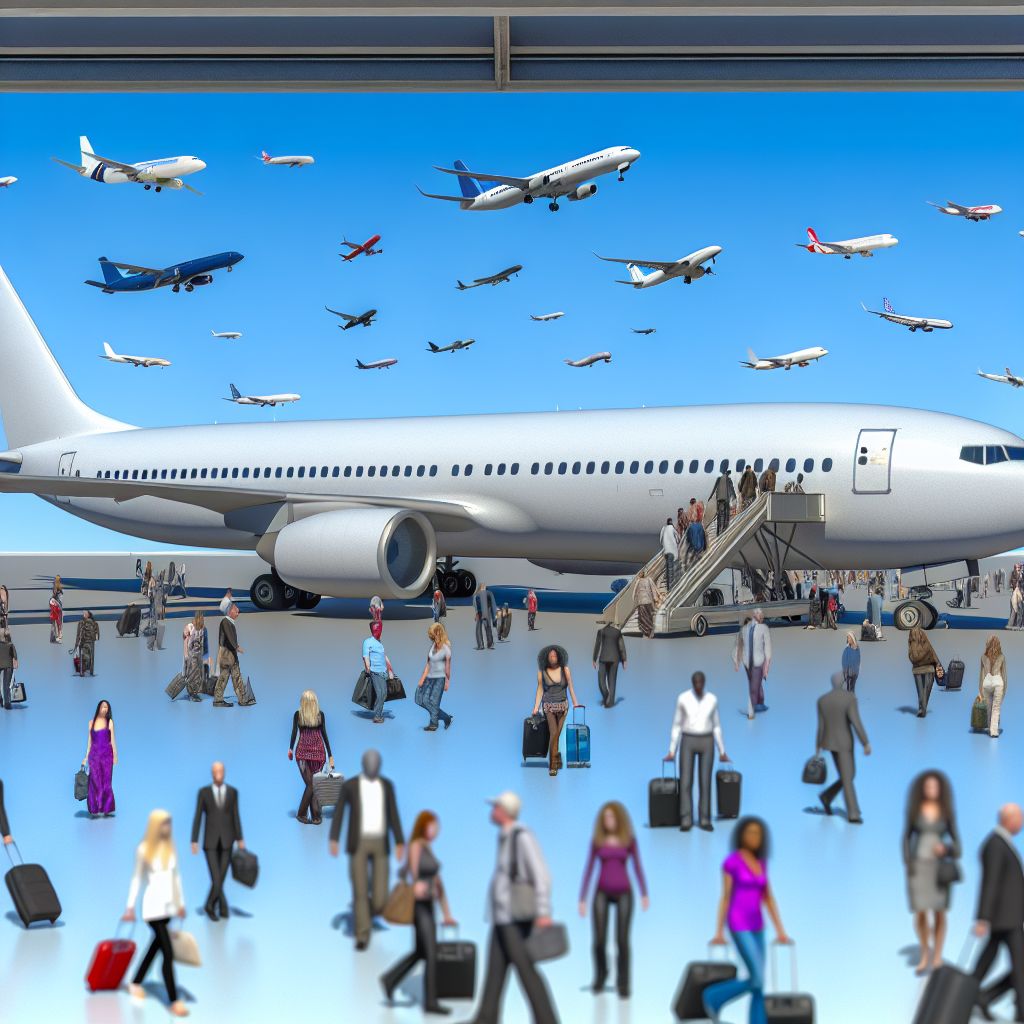Deutsch: Verkehrsflugzeug / Español: Avión comercial / Português: Avião comercial / Français: Avion de ligne / Italiano: Aereo di linea
An airliner is a type of aircraft designed for transporting passengers and cargo on scheduled air services. Airliners are characterized by their large size, passenger capacity, and range capabilities, enabling them to cover both short-haul and long-haul flights across the globe.
Description

Airliners play a pivotal role in the global travel industry, serving as the backbone of commercial aviation. These aircraft are engineered to meet rigorous safety and efficiency standards, offering various classes of service to accommodate the needs and preferences of travelers. The development of the airliner has revolutionized travel by making it possible for people to traverse vast distances in a matter of hours, rather than days or weeks.
Modern airliners come in various sizes and configurations, ranging from narrow-body aircraft for short to medium distances to wide-body jets capable of carrying hundreds of passengers over long distances without refueling. The design and technology of airliners have evolved significantly over time, focusing on improving fuel efficiency, reducing emissions, and enhancing passenger comfort. Innovations such as more efficient jet engines, advanced aerodynamics, and lightweight materials contribute to the airliner's performance and environmental Sustainability.
The history of airliners dates back to the early 20th century, with the development of the first passenger aircraft. Since then, the industry has seen dramatic changes, with significant advancements in technology and the emergence of major manufacturers like Boeing and Airbus. These companies continuously compete to produce the most advanced, efficient, and safe aircraft, driving the evolution of commercial aviation.
Application Areas
Airliners are utilized across the commercial aviation industry for various purposes, including:
- Passenger Transport: The primary function of airliners, carrying passengers from one destination to another quickly and safely.
- Cargo Transport: Many airliners are equipped to carry cargo in addition to passengers, providing essential services for global trade and logistics.
- Charter Services: Airliners are also used for charter flights, offering more flexible travel options for groups, sports teams, and corporate clients.
Well-Known Examples
Notable examples of airliners include:
- Boeing 747: Often referred to as the "Queen of the Skies," this iconic jumbo jet revolutionized long-haul travel with its significant passenger capacity and range.
- Airbus A380: Known for being the world's largest passenger airliner, the A380 offers unprecedented levels of comfort and amenities for long-distance flights.
- Boeing 737: One of the best-selling commercial jetliners, the 737 series serves short to medium-haul routes with exceptional efficiency and reliability.
Treatment and Risks
The operation and management of airliners involve addressing various risks and challenges to ensure safety and efficiency:
- Safety Regulations: Strict adherence to safety regulations and standards is paramount, with continuous training for crew and regular maintenance checks for aircraft.
- Environmental Impact: The aviation industry faces pressure to reduce its carbon footprint through more fuel-efficient aircraft and alternative fuels.
- Market Fluctuations: Airliners operate in a highly competitive and economically sensitive market, requiring airlines to adapt to changing demands and global economic conditions.
Similar Terms or Synonyms
- Commercial jet
- Passenger jet
- Commercial aircraft
Weblinks
Summary
Airliners are crucial to modern travel, offering fast, safe, and efficient transportation across the globe. Through continuous innovation and adherence to strict safety standards, the commercial aviation industry strives to meet the growing demand for air travel while minimizing its environmental impact. As technology advances, airliners will continue to evolve, shaping the future of global transportation.
--
Related Articles to the term 'Airliner' | |
| 'Standard' at glorious-Food-glossary.com | ■■■■■■■■■■ |
| Standard in the food context refers to established criteria or specifications that ensure the quality, . . . Read More | |
| 'Economy' | ■■■■■■■■■ |
| In the travel context, "Economy" typically refers to the most basic and affordable Class of service available . . . Read More | |
| 'Safety' | ■■■■■■■■■ |
| Safety in the travel context refers to the measures, practices, and considerations taken to protect travelers . . . Read More | |
| 'connecting flight' | ■■■■■■■■ |
| . . . Read More | |
| 'Aeroplane' at top500.de | ■■■■■■■■ |
| Aeroplane is an English term which is also known as airplane in American English, which refers to a mechanically, . . . Read More | |
| 'Cargo' | ■■■■■■■■ |
| Cargo (or freight) is goods or produce transported, generally for commercial gain, by Ship or aircraft, . . . Read More | |
| 'Aerodrome' | ■■■■■■■ |
| Aerodrome in the travel context refers to any Location that is designated for the Arrival, Departure, . . . Read More | |
| 'Wide-body' | ■■■■■■■ |
| Wide-body: A wide-body aircraft is a large airplane with a fuselage wide enough to accommodate two passenger . . . Read More | |
| 'Surveillance' at psychology-lexicon.com | ■■■■■■■ |
| Surveillance in the psychology context refers to the systematic observation or monitoring of individuals . . . Read More | |
| 'Reform' | ■■■■■■■ |
| A reform in the context of travel refers to changes or improvements made to policies, regulations, infrastructure, . . . Read More | |
